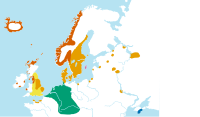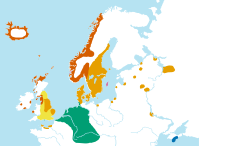
A | B | C | D | E | F | G | H | CH | I | J | K | L | M | N | O | P | Q | R | S | T | U | V | W | X | Y | Z | 0 | 1 | 2 | 3 | 4 | 5 | 6 | 7 | 8 | 9
| Old Norse | |
|---|---|
| Old Nordic | |
| dǫnsk tunga ('Danish tongue') norrǿnt mál ('Northern speech') | |
| Native to | Scandinavia, Iceland, Faroe Islands, Greenland and other Norse settlements |
| Region | Nordic countries, Great Britain, Ireland, Isle of Man, Normandy, Newfoundland, the Volga and places in-between |
| Ethnicity | Norsemen and their descendants |
| Era | Evolved from Proto-Norse in the 8th century, developed into the various North Germanic languages by the 15th century |
Indo-European
| |
Early form | Proto-Norse (attested)
|
| Runic, later Latin (Old Norse alphabet) | |
| Language codes | |
| ISO 639-2 | non |
| ISO 639-3 | non |
| Glottolog | oldn1244 |
| Part of a series on |
| Old Norse |
|---|
 |
| WikiProject Norse history and culture |
| Part of a series on the |
| Norsemen |
|---|
 |
| WikiProject Norse history and culture |
Old Norse, Old Nordic,[1] or Old Scandinavian is a stage of development of North Germanic dialects before their final divergence into separate Nordic languages. Old Norse was spoken by inhabitants of Scandinavia and their overseas settlements and chronologically coincides with the Viking Age, the Christianization of Scandinavia and the consolidation of Scandinavian kingdoms from about the 8th to the 15th centuries.[2]
The Proto-Norse language developed into Old Norse by the 8th century, and Old Norse began to develop into the modern North Germanic languages in the mid-to-late 14th century, ending the language phase known as Old Norse. These dates, however, are not absolute, since written Old Norse is found well into the 15th century.[3][better source needed]
Old Norse was divided into three dialects: Old West Norse or Old West Nordic (often referred to as Old Norse[4]), Old East Norse or Old East Nordic, and Old Gutnish. Old West Norse and Old East Norse formed a dialect continuum, with no clear geographical boundary between them. For example, Old East Norse traits were found in eastern Norway, although Old Norwegian is classified as Old West Norse, and Old West Norse traits were found in western Sweden. Most speakers spoke Old East Norse in what is present-day Denmark and Sweden. Old Gutnish is sometimes included in the Old East Norse dialect due to geographical associations. It developed its own unique features and shared in changes to both other branches.[5]
The 12th-century Icelandic Gray Goose Laws state that Swedes, Norwegians, Icelanders, and Danes spoke the same language, dǫnsk tunga ("Danish tongue"; speakers of Old East Norse would have said dansk tunga). Another term was norrœnt mál ("northern speech"). Today Old Norse has developed into the modern North Germanic languages Icelandic, Faroese, Norwegian, Danish, Swedish, and other North Germanic varieties of which Norwegian, Danish and Swedish retain considerable mutual intelligibility while Icelandic remains the closest to Old Norse.
Geographical distribution

Old Icelandic was very close to Old Norwegian, and together they formed Old West Norse, which was also spoken in Norse settlements in Greenland, the Faroes, Ireland, Scotland, the Isle of Man, northwest England, and in Normandy.[6] Old East Norse was spoken in Denmark, Sweden, Kievan Rus',[7] eastern England, and Danish settlements in Normandy. The Old Gutnish dialect was spoken in Gotland and in various settlements in the East.
In the 11th century, Old Norse was the most widely spoken European language, ranging from Vinland in the West to the Volga River in the East. In Kievan Rus', it survived the longest in Veliky Novgorod, probably lasting into the 13th century there.[7] The age of the Swedish-speaking population of Finland is strongly contested, but Swedish settlement had spread the language into the region by the time of the Second Swedish Crusade in the 13th century at the latest.[citation needed]
Modern descendants
The modern descendants of the Old West Norse dialect are the West Scandinavian languages of Icelandic, Faroese, Norwegian, and the extinct Norn language of Orkney and Shetland; the descendants of the Old East Norse dialect are the East Scandinavian languages of Danish and Swedish. Norwegian is descended from Old West Norse, but over the centuries it has been heavily influenced by East Norse, particularly during the Denmark–Norway union.
Among these, the grammar of Icelandic and Faroese have changed the least from Old Norse in the last thousand years. In contrast, the pronunciations of both Icelandic and Faroese have changed considerably from Old Norse. With Danish rule of the Faroe Islands, Faroese has also been influenced by Danish.
Both Middle English and Early Scots were strongly influenced by Norse – especially dialects from northern England, within the area of the Danelaw, and Lowland Scots, both of which contained many Old Norse loanwords. Consequently, Modern English (including Scottish English), inherited a significant proportion of its vocabulary directly from Norse.
The development of Norman French was also influenced by Norse. Through Norman, to a smaller extent, so was modern French.
Written modern Icelandic derives from the Old Norse phonemic writing system. Contemporary Icelandic-speakers can read Old Norse, which varies slightly in spelling as well as semantics and word order. However, pronunciation, particularly of the vowel phonemes, has changed at least as much in Icelandic as in the other North Germanic languages.
Faroese retains many similarities but is influenced by Danish, Norwegian, and Gaelic (Scottish and/or Irish).[8] Although Swedish, Danish and Norwegian have diverged the most, they still retain considerable mutual intelligibility.[9] Speakers of modern Swedish, Norwegian and Danish can mostly understand each other without studying their neighboring languages, particularly if speaking slowly. The languages are also sufficiently similar in writing that they can mostly be understood across borders. This could be because these languages have been mutually affected by each other, as well as having a similar development influenced by Middle Low German.[10]
Other influenced languages
Various languages unrelated to Old Norse and others not closely related have been heavily influenced by Norse, particularly the Norman language; to a lesser extent, Finnish and Estonian. Russian, Ukrainian, Belarusian, Lithuanian and Latvian also have a few Norse loanwords. The words Rus and Russia, according to one theory, may be named after the Rus' people, a Norse tribe, probably from present-day east-central Sweden. The current Finnish and Estonian words for Sweden are Ruotsi and Rootsi, respectively.
A number of loanwords have been introduced into Irish, many associated with fishing and sailing.[11][12][13][14] A similar influence is found in Scottish Gaelic, with over one hundred loanwords estimated to be in the language, many of which are related to fishing and sailing.[15][16][17]
Phonology
Vowels
The vowel phonemes mostly come in pairs of long and short. The standardized orthography marks the long vowels with an acute accent. In medieval manuscripts, it is often unmarked but sometimes marked with an accent or through gemination.
Old Norse had nasalized versions of all ten vowel places.[cv 1][obsolete source] These occurred as allophones of the vowels before nasal consonants and in places where a nasal had followed it in an older form of the word, before it was absorbed into a neighboring sound. If the nasal was absorbed by a stressed vowel, it would also lengthen the vowel. This nasalization also occurred in the other Germanic languages, but were not retained long. They were noted in the First Grammatical Treatise, and otherwise might have remained unknown. The First Grammarian marked these with a dot above the letter.[cv 1] This notation did not catch on, and would soon be obsolete. Nasal and oral vowels probably merged around the 11th century in most of Old East Norse.[18] However, the distinction still holds in Dalecarlian dialects.[19] The dots in the following vowel table separate the oral from nasal phonemes.
| Front vowels | Back vowels | |||||||
|---|---|---|---|---|---|---|---|---|
| Unrounded | Rounded | Unrounded | Rounded | |||||
| Close | i • ĩ | iː • ĩː | y • ỹ | yː • ỹː | u • ũ | uː • ũː | ||
| Mid | e • ẽ | eː • ẽː | ø • ø̃ | øː • ø̃ː | o • õ | oː • õː | ||
| Open, open-mid | ɛ • ɛ̃ | ɛː • ɛ̃ː | œ • œ̃ | a • ã | aː • ãː | ɔ • ɔ̃ | ɔː • ɔ̃ː | |
Note: The open or open-mid vowels may be transcribed differently:
- /æ/ = /ɛ/
- /ɒ/ = /ɔ/
- /ɑ/ = /a/
Sometime around the 13th century, /ɔ/ (spelled ⟨ǫ⟩) merged with /ø/ or /o/ in most dialects except Old Danish, and Icelandic where /ɔ/ (ǫ) merged with /ø/. This can be determined by their distinction within the 12th-century First Grammatical Treatise but not within the early 13th-century Prose Edda. The nasal vowels, also noted in the First Grammatical Treatise, are assumed to have been lost in most dialects by this time (but notably they are retained in Elfdalian and other dialects of Ovansiljan). See Old Icelandic for the mergers of /øː/ (spelled ⟨œ⟩) with /ɛː/ (spelled ⟨æ⟩) and /ɛ/ (spelled ⟨ę⟩) with /e/ (spelled ⟨e⟩).
| Front vowels | Back vowels | |||||||
|---|---|---|---|---|---|---|---|---|
| Unrounded | Rounded | Unrounded | Rounded | |||||
| High | i | iː | y | yː | u | uː | ||
| Mid | e | eː | ø | øː | o | oː | ||
| Low/Low-mid | ɛ | ɛː | a | aː | ||||
Old Norse had three diphthong phonemes: /ɛi/, /ɔu/, /øy ~ ɛy/ (spelled ⟨ei⟩, ⟨au⟩, ⟨ey⟩ respectively). In East Norse these would monophthongize and merge with /eː/ and /øː/, whereas in West Norse and its descendants the diphthongs remained.
| Proto-Germanic | Northwest Germanic | Primitive Old West Norse | Old Icelandic (1st Grammarian) |
Later Old Icelandic | Example (Old Norse) |
|---|---|---|---|---|---|
| a | a | a ⟨a⟩ | a | a | land "land" < *landą |
| a | a (+i-mut) | ɛ ⟨ę⟩ | e ⟨e⟩ | e | menn "men" < *manniz |
| a | a (+u/w-mut) | ɔ ⟨ǫ⟩ | ɔ | ø ⟨ö⟩ | lǫnd "lands" < *landu < *landō; sǫngr "song" < sǫngr < *sangwaz |
| a | a (+i-mut +w-mut) | œ ⟨ø₂⟩ | ø | ø ⟨ö⟩ | gøra "to make" < *garwijaną |
| æː ⟨ē⟩ | aː | aː ⟨á⟩ | aː | aː | Zdroj:https://en.wikipedia.org?pojem=Old_Norse_language
